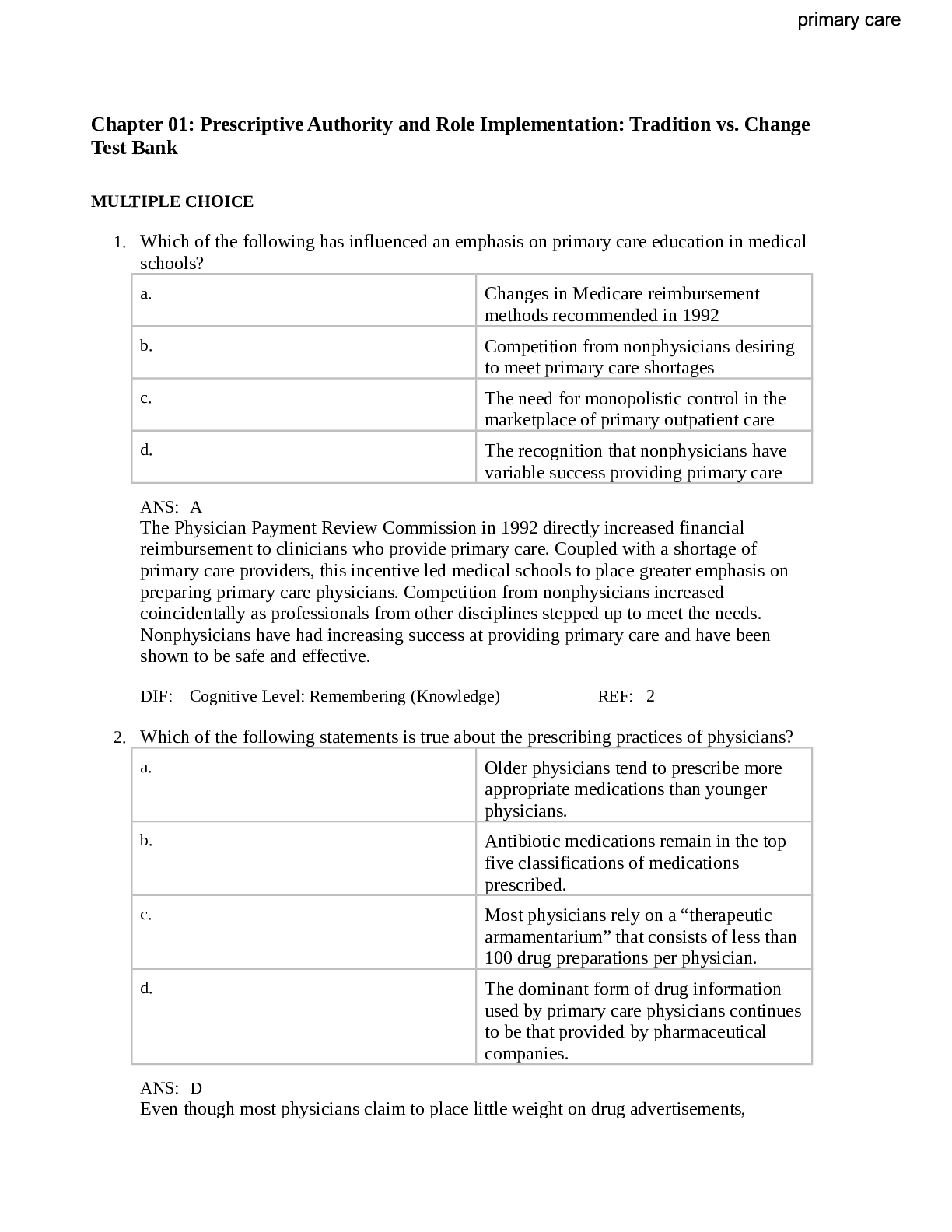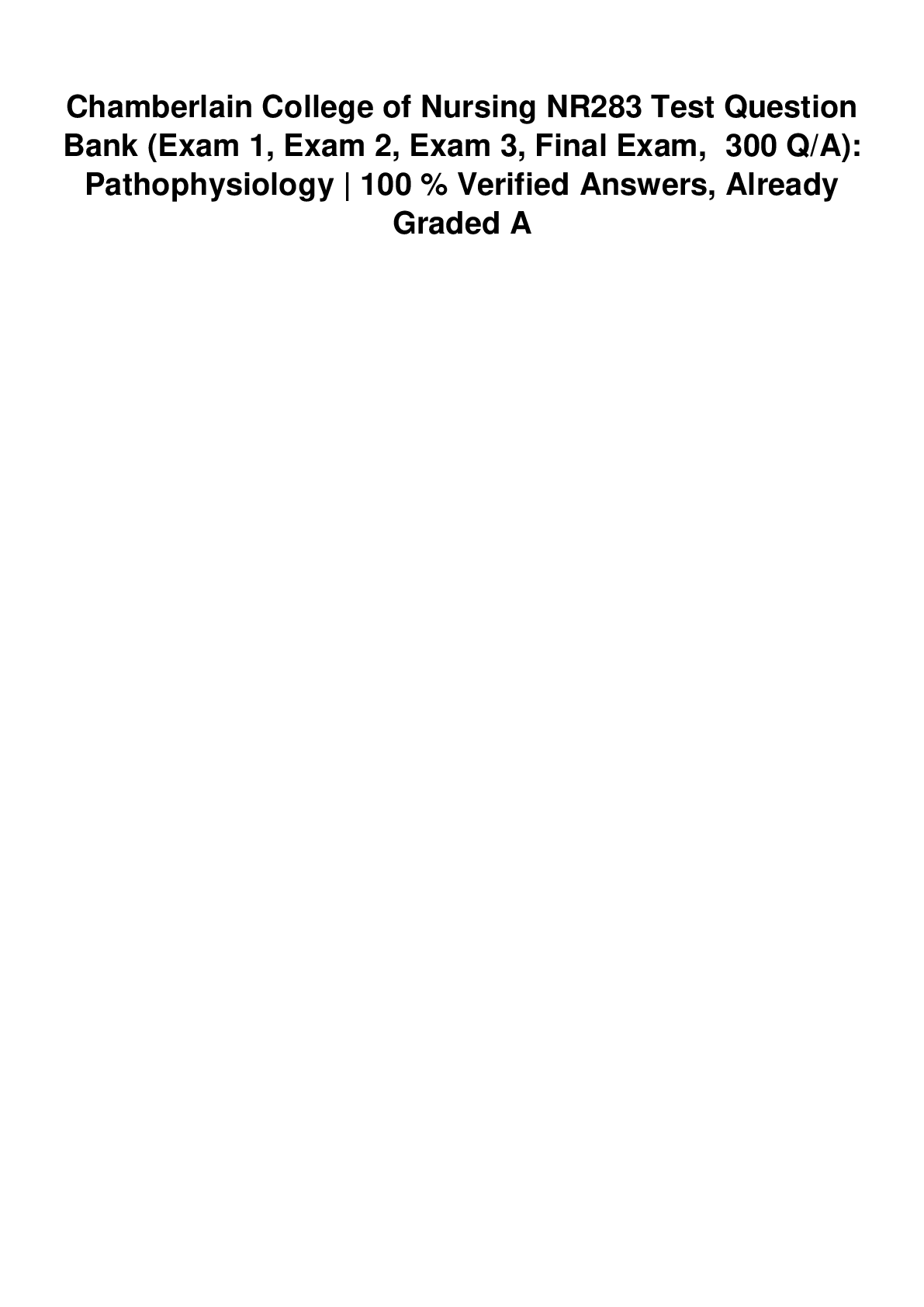*NURSING > TEST BANK > LEADERSHIP TESTBANK 2021 | Questions and Answers | All Correct | NR 504 Chamberlain College of Nursi (All)
LEADERSHIP TESTBANK 2021 | Questions and Answers | All Correct | NR 504 Chamberlain College of Nursing
Document Content and Description Below
Chapter 01: Leadership and Management Principles Test Bank MULTIPLE CHOICE 1. Leadership is best defined as: a. an interpersonal process of participating by encouraging fellowship. b. delegation ... of authority and responsibility and the coordination of activities. c. inspiring people to accomplish goals through support and confidence building. d. the integration of resources through planning, organizing, and directing. ANS: C Leadership is the process of influencing people to accomplish goals by inspiring confidence and support among followers. DIF: Cognitive Level: Remember (Knowledge) REF: Page 4 TOP: Nursing Process: Assessment MSC: Client Needs: Safe and Effective Care Environment: Management of Care 2. A medical-surgical unit reports higher rates of patient satisfaction coupled with high rates of staff satisfaction and productivity. Which of the following is attributed to the data? a. Effective leadership b. Management involvement c. Mentoring d. Rewards and recognition ANS: A Effective leadership is important in nursing because of the impact on nurses’ work lives, it being a stabilizing influence during change, and for nurses’ productivity and quality of care. DIF: Cognitive Level: Apply (Application) REF: Page 1 TOP: Nursing Process: Assessment MSC: Client Needs: Safe and Effective Care Environment: Management of Care 3. A staff registered nurse (RN) is leading a multidisciplinary clinical pathway team in the development of care for patients with total knee replacement. Which of the following statements would exemplify leadership behaviors in a clinical pathway team meeting? a. “Nursing is responsible for pain control of the total knee replacement patient.” b. “Our pharmacist has provided some excellent pain control literature.” c. “Physical therapy’s expertise is in rehabilitation, not pain control.” d. “Total knee replacement patients require optimal pain control.” ANS: B Leadership is the process of influencing people to accomplish goals by inspiring confidence and support among followers. The correct answer is supportive of a team member’s work and depicts some skill at interpersonal relationships. DIF: Cognitive Level: Apply (Application) REF: Pages 3-4 TOP: Nursing Process: Assessment MSC: Client Needs: Physiological Integrity: Pharmacological and Parenteral Therapies 4. Which of the following is true of management activities? a. Inspiring a vision is a management function. b. Management is focused on task accomplishment. c. Management is more focused on human relationships. d. Management is more important than leadership. ANS: B Management is focused on task accomplishment. DIF: Cognitive Level: Remember (Knowledge) REF: Pages 2-3 TOP: Nursing Process: Assessment MSC: Client Needs: Safe and Effective Care Environment: Management of Care 5. During a staff meeting, a group of RNs has complained that medications are not arriving to the unit in a timely manner. The nurse manager suggests that the group resolve this issue through the development and work of a multidisciplinary team led by one of these RNs. This scenario demonstrates: a. adaptation. b. empowerment. c. flexibility. d. relationship management. ANS: B Empowerment is the giving of authority, responsibility, and the freedom to act. In this situation, the manager has given authority, responsibility, and the freedom to act in the investigation and resolution of this issue. DIF: Cognitive Level: Apply (Application) REF: Page 5 TOP: Nursing Process: Assessment MSC: Client Needs: Safe and Effective Care Environment: Management of Care 6. A nurse is caring for an elderly patient who was admitted after sustaining a fall at home. When creating a care plan for the patient, she requests that the doctor order a home health visit to assess for home safety and medication compliance. In addition, the nurse is concerned about the nutrition of the patient and requests a dietitian evaluation. The nurse is demonstrating which of the following leadership skills? a. Care provider b. Business principles c. Care coordination d. Change management ANS: C Care coordination is the delivery of nursing services that involves the organization and coordination of complex activities. The nurse uses managerial and leadership skills to facilitate delivery of quality care. DIF: Cognitive Level: Apply (Application) REF: Page 3 TOP: Nursing Process: Planning MSC: Client Needs: Physiological Integrity: Reduction of Risk Potential 7. Interpersonal communication and the ability to apply _____ are two critical skills every nurse needs to enhance professional practice. a. vision b. supervision c. delegation d. problem solving ANS: D Every nurse needs two critical skills to enhance professional practice. One is a skill at interpersonal relationships. This is fundamental to leadership and the work of nursing. The second skill is applying the problem-solving process. This involves critical thinking, problem identification, and the development of objectivity. DIF: Cognitive Level: Remember (Knowledge) REF: Page 4 TOP: Nursing Process: Assessment MSC: Client Needs: Safe and Effective Care Environment: Management of Care 8. Good leaders need to be able to demonstrate an intuitive skill of empathy and expressiveness when dealing with others in the workplace. This requires sensitivity and awareness of the emotions and moods of others and is known as: a. social awareness. b. self-awareness. c. self-management. d. relationship management. ANS: A Social awareness is an intuitive skill of empathy and expressiveness in being sensitive and aware of the emotions and moods of others. DIF: Cognitive Level: Remember (Knowledge) REF: Page 4 TOP: Nursing Process: Assessment MSC: Client Needs: Safe and Effective Care Environment: Management of Care 9. The manager of the emergency department in a large hospital focuses on customer service, exudes the nursing code of ethics, and sees his or her job as an occupation with a lifetime commitment. This is a concept known as: a. leadership. b. management. c. professionalism. d. vision. ANS: C Professionalism is an approach to an occupation that distinguishes it from being merely a job, focuses on service as the highest ideal, follows a code of ethics, and is seen as a lifetime commitment. DIF: Cognitive Level: Remember (Knowledge) REF: Page 5 TOP: Nursing Process: Implementation MSC: Client Needs: Safe and Effective Care Environment: Management of Care 10. _____ are vital to good leaders because they are able to take the vision of the leader and achieve the determined goals. a. Managers b. Motivators c. Visionaries d. Followers ANS: D Without followers there is not leadership. Followers are vital because they accept or reject the leader and determine the leader’s personal power. DIF: Cognitive Level: Remember (Knowledge) REF: Page 6 TOP: Nursing Process: Assessment MSC: Client Needs: Safe and Effective Care Environment: Management of Care 11. The best leadership style for unfavorable conditions is: a. leader–member relations. b. task-oriented structure. c. position power. d. laissez faire. ANS: B The need for task-oriented leaders occurs when the situation is extreme. The best leadership style for unfavorable conditions is task-oriented. DIF: Cognitive Level: Remember (Knowledge) REF: Pages 10, 12 TOP: Nursing Process: Assessment MSC: Client Needs: Safe and Effective Care Environment: Management of Care 12. Nursing management is defined as: a. delegation of authority and responsibility and the coordination of tasks. b. the integration of resources through planning, organizing, and directing. c. the process of influencing patients to accomplish goals. d. the coordination and integration of nursing resources by applying the management process to accomplish nursing care and service goals and objectives. ANS: D The coordination and integration of nursing resources by applying the management process to accomplish nursing care and service goals and objectives is the definition of nursing management. DIF: Cognitive Level: Remember (Knowledge) REF: Page 22 TOP: Nursing Process: Assessment MSC: Client Needs: Safe and Effective Care Environment: Management of Care 13. A nursing unit has demonstrated lower patient satisfaction scores during the last quarter. The manager of the unit has formed a small team to set long- and short-term goals for the unit with action plans to increase patient satisfaction. This is an example of which management process? a. Planning b. Organizing c. Coordinating d. Controlling ANS: A Planning is the managerial function of selecting priorities, results, and methods to achieve results. DIF: Cognitive Level: Apply (Application) REF: Pages 23-24 TOP: Nursing Process: Planning MSC: Client Needs: Safe and Effective Care Environment: Management of Care 14. A nursing unit has discovered a series of medication errors with regards to a particular computerized physician order set and the calculation within the order. The unit manager has a theory on changes that should be made within the order to decrease the confusion for nursing staff. However, the nurse manager realizes that changes would need to be made with pharmacy input as well as other nursing units within the facility and the multi-hospital system. Which of the following management theories is exemplified when the nurse manager considers the impact of change on the organization as a whole? a. Contingency theory b. Systems theory c. Complexity theory d. Chaos theory ANS: B Systems theory helps managers recognize their work as being embedded within a system. Managers use this theory to learn that changing one part of a system inevitably affects the whole system. DIF: Cognitive Level: Apply (Application) REF: Pages 30-32 TOP: Nursing Process: Planning MSC: Client Needs: Physiological Integrity: Reduction of Risk Potential 15. The role of the _____ is to provide leadership and direction for all aspects of nursing care. a. nurse manager b. care provider c. nurse executive d. senior leader ANS: C The nurse executive is accountable for the environment in which clinical nursing practice occurs. The nurse executive provides leadership and direction for all aspects of nursing care. DIF: Cognitive Level: Remember (Knowledge) REF: Page 34 TOP: Nursing Process: Assessment MSC: Client Needs: Safe and Effective Care Environment: Management of Care 16. The postoperative patient with anterior cervical laminectomy is complaining of tightness in his throat. His voice is raspy. The staff nurse asks the unit secretary to page Dr. Julio stat. This is an example of _____ leadership. a. authoritarian b. democratic c. laissez-faire d. servant ANS: A Authoritarian leadership uses directive and controlling behaviors in which the leader determines policies and makes decisions in isolation. The leader orders subordinates to carry out the tasks or work. This style is helpful in crisis situations. DIF: Cognitive Level: Apply (Application) REF: Page 10 TOP: Nursing Process: Implementation MSC: Client Needs: Physiological Integrity: Physiological Adaptation 17. A quality improvement team is working to enhance teamwork among the staff in a newly developed Alzheimer’s program. Which of the following statements would be an expected behavior that illustrates quantum leadership? a. “After the meeting today, each member on this team will be a role model of good communication techniques to other staff members.” b. “How would you describe an ideal collaborative practice environment?” c. “What do you think about sharing our opinions today in a mutually respectful manner as we move around the table?” d. “You folks are highly motivated and smart enough to develop a plan on your own. I’ll support you as needed.” ANS: B Quantum leadership fosters an environment of curiosity, questioning, and exploration. Answer A depicts an authoritarian leadership style. DIF: Cognitive Level: Apply (Application) REF: Page 16 TOP: Nursing Process: Evaluation MSC: Client Needs: Safe and Effective Care Environment: Management of Care 18. A nursing executive is leading a multidisciplinary team of professionals who have worked well together on prior initiatives. Which of the following leadership styles might work best in this situation? a. Authoritarian b. Democratic c. Transformational d. Transactional ANS: B Democratic leadership would work best in this situation. DIF: Cognitive Level: Apply (Application) REF: Pages 10, 14 TOP: Nursing Process: Planning MSC: Client Needs: Safe and Effective Care Environment: Management of Care MULTIPLE RESPONSE 1. Which of the following behavioral aspects are present in the feminist perspective leadership style (select all that apply)? a. Builds relationships b. Focuses on completing tasks and achieving goals c. Empowers others d. Fosters an environment of mothering e. Supports bargaining of tasks and roles f. Promotes personal growth ANS: A, C, F Leaders using the feminist perspective build connections, empower others, and support personal growth to promote teamwork and to accomplish goals. DIF: Cognitive Level: Understand (Comprehension) REF: Page 11 TOP: Nursing Process: Assessment MSC: Client Needs: Safe and Effective Care Environment: Management of Care 2. A nurse manager at Great Lakes Hospital is meeting with the dean of a well-recognized university who is the keynote speaker today at the nursing conference. He remembers that one of the RNs is interested in attending a well-known university to obtain a doctorate. The nurse manager arranges for the RN to meet with this dean. The nurse manager is exhibiting leadership behaviors consistent with (select all that apply): a. feminist perspective. b. servant leadership. c. transactional leadership. d. transformational leadership. ANS: A, B, D This behavior nurtures personal growth (servant leadership) and assists the RN to attain his or her fullest potential (transformational leadership). This behavior also helps the RN build a connection with the dean, a representative of the university (feminist perspective). DIF: Cognitive Level: Apply (Application) REF: Pages 11, 14, 16 TOP: Nursing Process: Implementation MSC: Client Needs: Safe and Effective Care Environment: Management of Care 3. A nurse manager at Morgan Hill Community Hospital is known to be an excellent nursing manager by the personnel working on her nursing unit. The nurse manager exhibits which of the following behaviors (select all that apply)? a. Knows the personnel and addresses them by name b. Intervenes when she receives complaints c. Has a consistent style that never varies d. Is visible on the nursing unit by all shifts on a frequent basis e. Evaluates a number of aspects of problems prior to making decisions f. Uses decision by consensus to resolve conflicts g. Fosters collaboration ANS: A, D, E, G These behaviors foster teamwork and positive morale. DIF: Cognitive Level: Apply (Application) REF: Pages 6-8 TOP: Nursing Process: Implementation MSC: Client Needs: Safe and Effective Care Environment: Management of Care 4. To reach Magnet status the nursing service in a hospital must attain competency in which of the following areas (select all that apply)? a. Professionalism b. Use of critical thinking skills c. Business skills and principles d. Leadership e. Communication and relationship management f. Knowledge of the health care environment g. Implementation of an acuity-based staffing system ANS: A, C, D, E, F Magnet hospitals are recognized for the nurse’s critical role in the business of health care. Professionalism, leadership, communication, and the ability to work with others as well as understanding the business and principles of running a hospital business and health care environment are required. DIF: Cognitive Level: Apply (Application) REF: Pages 2-3 TOP: Nursing Process: Evaluation MSC: Client Needs: Safe and Effective Care Environment: Management of Care 5. Which of the following behaviors build trust between leaders and employees in an organization (select all that apply)? a. Sharing relevant information b. Encouraging competition via winners and losers c. Reducing controls d. Meeting expectations e. Avoiding discussion of sensitive issues ANS: A, C, D Leadership is founded on trust. Behaviors that build trust include sharing relevant information, reducing controls, and meeting expectations. Trust-destroying behaviors include being insensitive to beliefs and values, avoiding discussion of sensitive issues, and encouraging competition. DIF: Cognitive Level: Apply (Application) REF: Pages 8-9 TOP: Nursing Process: Evaluation MSC: Client Needs: Safe and Effective Care Environment: Management of Care 6. Which of the following traits describe a transactional leader (select all that apply)? a. Functions in a caregiver role b. Surveys their followers’ needs and sets goals for them c. Uses charisma to produce greater effort in followers d. Focuses on the maintenance and management of ongoing and routine work e. Motivates followers to perform to their full potential ANS: A, B, D A transactional leader is a leader or manager who functions in a caregiver role and is focused on day-to-day operations. Such leaders survey their followers’ needs and set goals for them based on expectations. They are also leaders who are focused on maintenance and management of ongoing and routine work. Transformational leaders use charisma to produce greater effort and are able to motivate followers to perform to their full potential over time. DIF: Cognitive Level: Remember (Knowledge) REF: Page 14 TOP: Nursing Process: Implementation MSC: Client Needs: Safe and Effective Care Environment: Management of Care 7. Which of the following factors are central to successful nursing leadership (select all that apply)? a. Access to information and resources b. Respectful and collaborative teamwork c. Supportive cultures in which nurses are valued for their expertise d. Formal and informal power e. Vertical compensation ANS: A, B, C, D Formal and informal power, access to information and resources, opportunity for growth, supportive organizational cultures in which nurses are valued for their expertise, respectful teamwork, and adequate compensation are factors central to successful nursing leadership. DIF: Cognitive Level: Remember (Knowledge) REF: Page 17 TOP: Nursing Process: Assessment MSC: Client Needs: Safe and Effective Care Environment: Management of Care 8. Which of the following definitions apply to management (select all that apply)? a. It is a process of inspiring people to accomplish goals through support and confidence building. b. It is the process of coordination and integration of resources to accomplish specific goals. c. It includes the activities of planning, organizing, coordinating, directing, and controlling. d. It is a process of planning and directing human effort to achieve established objectives. e. It is the directing of the organizations’ money, facilities, and supplies to achieve results. ANS: B, C, D, E Management is defined as the process of coordination and integration of resources through planning, organizing, coordinating, directing, and controlling to accomplish specific goals. Management is a process of planning and directing human effort to achieve established objectives while ensuring that the organizations’ money, facilities and supplies are directed in a manner which achieves the best results. DIF: Cognitive Level: Apply (Application) REF: Page 21 TOP: Nursing Process: Evaluation MSC: Client Needs: Safe and Effective Care Environment: Management of Care Chapter 04: Critical Thinking and Decision-Making Skills Test Bank MULTIPLE CHOICE 1. What is the definition of the process of making choices that will provide maximum benefit? a. Critical thinking b. Problem solving c. Decision making d. Leading ANS: C Decision making is the process of making choices that will provide maximum benefits. DIF: Cognitive Level: Remember (Knowledge) REF: Page 66 TOP: Nursing Process: Assessment MSC: Client Needs: Safe and Effective Care Environment: Management of Care 2. A patient has arrived at the critical care unit with a head injury. On admission, the patient is talking and is a little drowsy but oriented. Two hours later, the nurse discovers that the patient is talking at a rapid pace and keeps repeating his words. Which of the following examples best depicts Benner’s stages and appropriate critical-thinking processes in this situation? a. Advanced beginner—thinks that the patient is trying to be funny b. Competent—thinks that the patient is experiencing effects from cerebral edema c. Novice—thinks that the patient is stressed and has had a surge of adrenaline d. Proficient—thinks that the patient is waking up from a coma ANS: B The competent nurse uses the information about head injury, change in mental status from talking and drowsy but oriented to talking at a rapid pace, and the potential for the patient to deteriorate to discern that the patient is experiencing cerebral edema or increased intracranial pressure. DIF: Cognitive Level: Analyze (Analysis) REF: Pages 67-68 TOP: Nursing Process: Assessment MSC: Client Needs: Physiological Integrity: Physiological Adaptation 3. A staff registered nurse (RN) has been struggling with the delivery system from central supply. He documents a delay of 1 to 3 hours from the time that the order is sent to central supply to the time that the requested equipment is sent to the floor. The RN asks, “Why does a central supply unit need to service the entire hospital? Why not consider a decentralized central supply established for each floor?” This is an example of what type of thinking? a. Amiable thinker b. Critical thinker c. Traditional thinker d. Unrealistic thinker ANS: B A critical thinker challenges and questions the norm. DIF: Cognitive Level: Apply (Application) REF: Page 67 TOP: Nursing Process: Assessment MSC: Client Needs: Safe and Effective Care Environment: Management of Care 4. A staff RN is leading a quality improvement team on the care of the total hip replacement patient. The issue is an increased length of stay from 1 year ago. The nurse asks team members to reframe the problem statement from their perspective. Twenty different problem statements were developed. The team is focusing on four of the problem statements. This is an example of which of the following techniques? a. Problem solving b. Evaluating the consequences c. Inclusive judgment d. Problem processing ANS: A Problem solving occurs when moving from an undesirable to a desirable state. It occurs in a variety of nursing cont [Show More]
Last updated: 1 year ago
Preview 1 out of 146 pages

Reviews( 0 )
Document information
Connected school, study & course
About the document
Uploaded On
Sep 05, 2021
Number of pages
146
Written in
Additional information
This document has been written for:
Uploaded
Sep 05, 2021
Downloads
0
Views
44

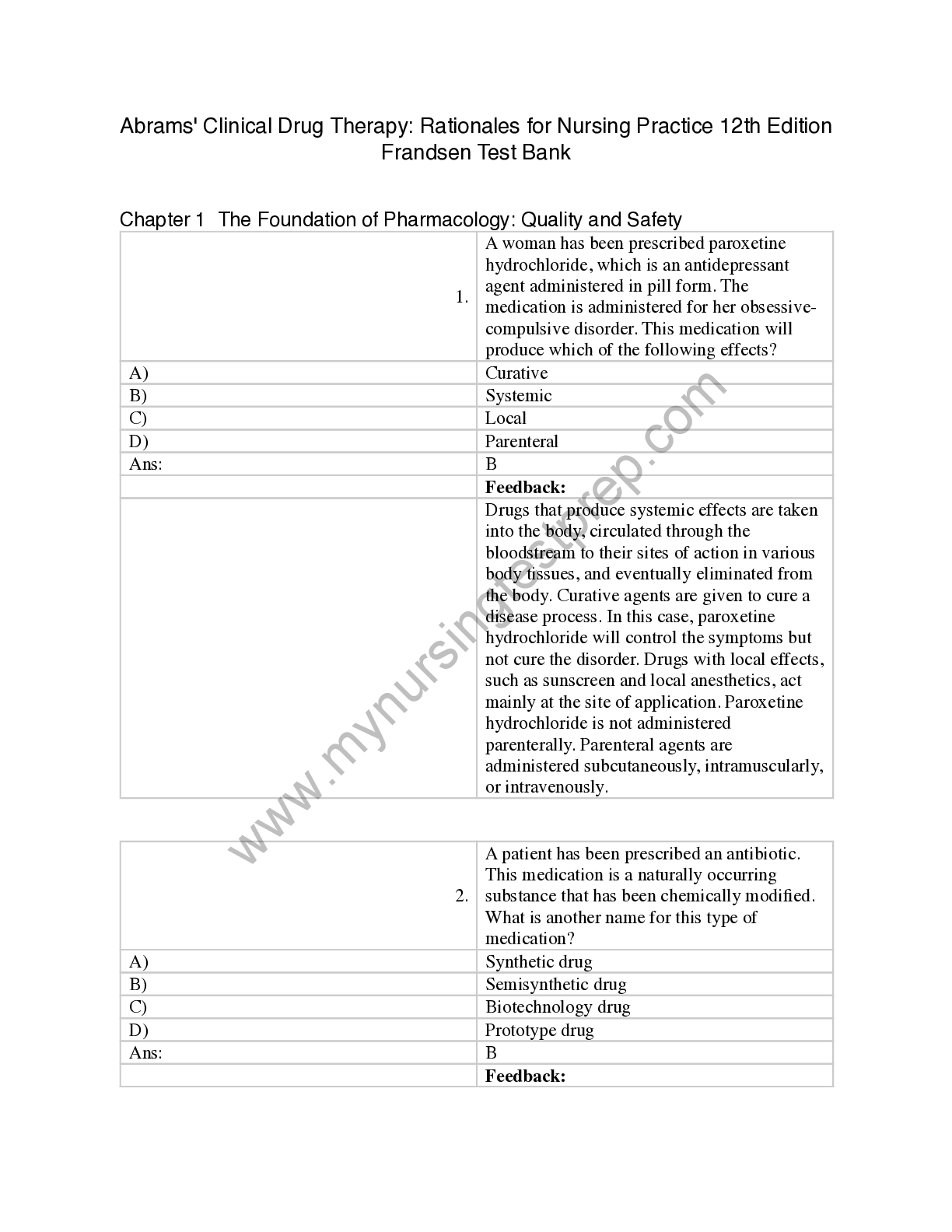





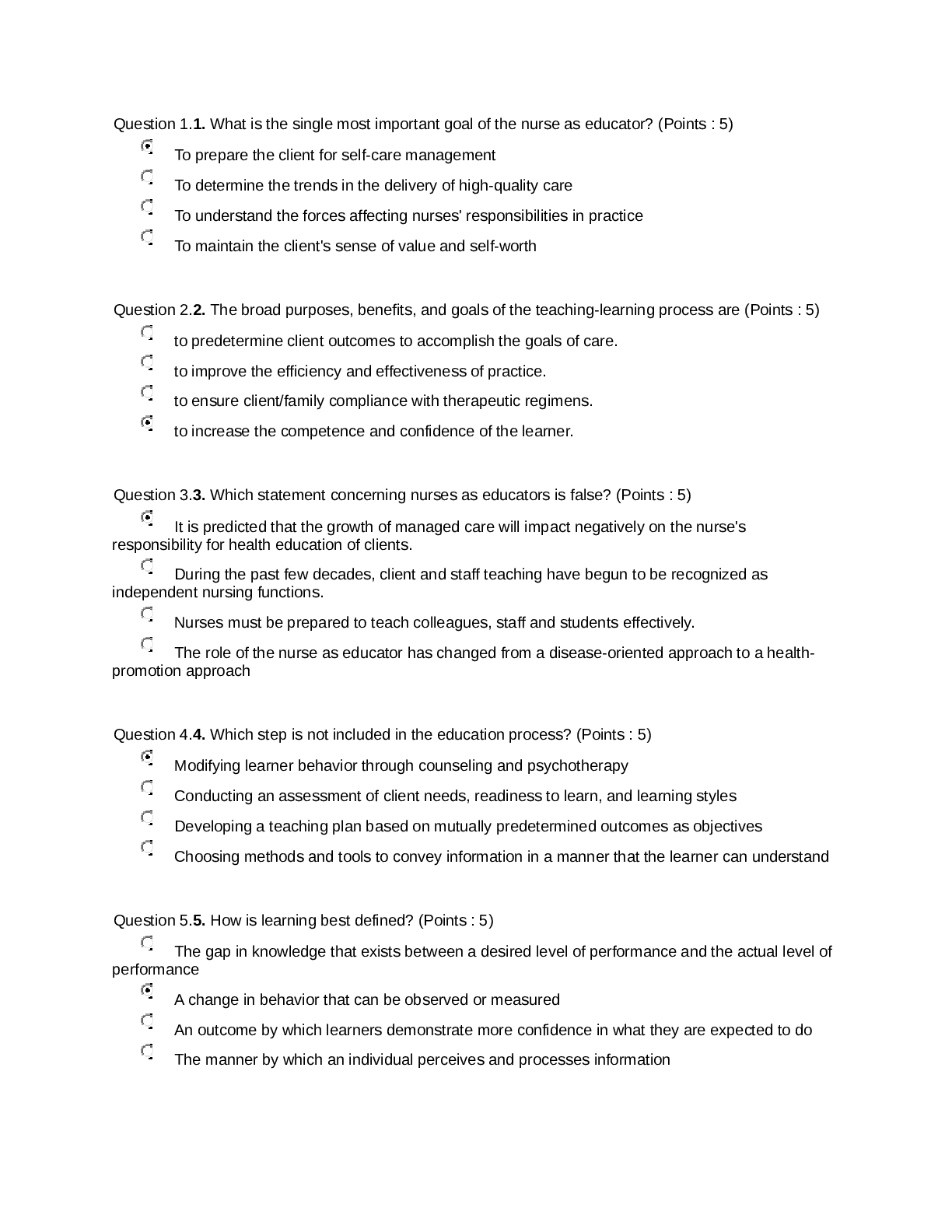
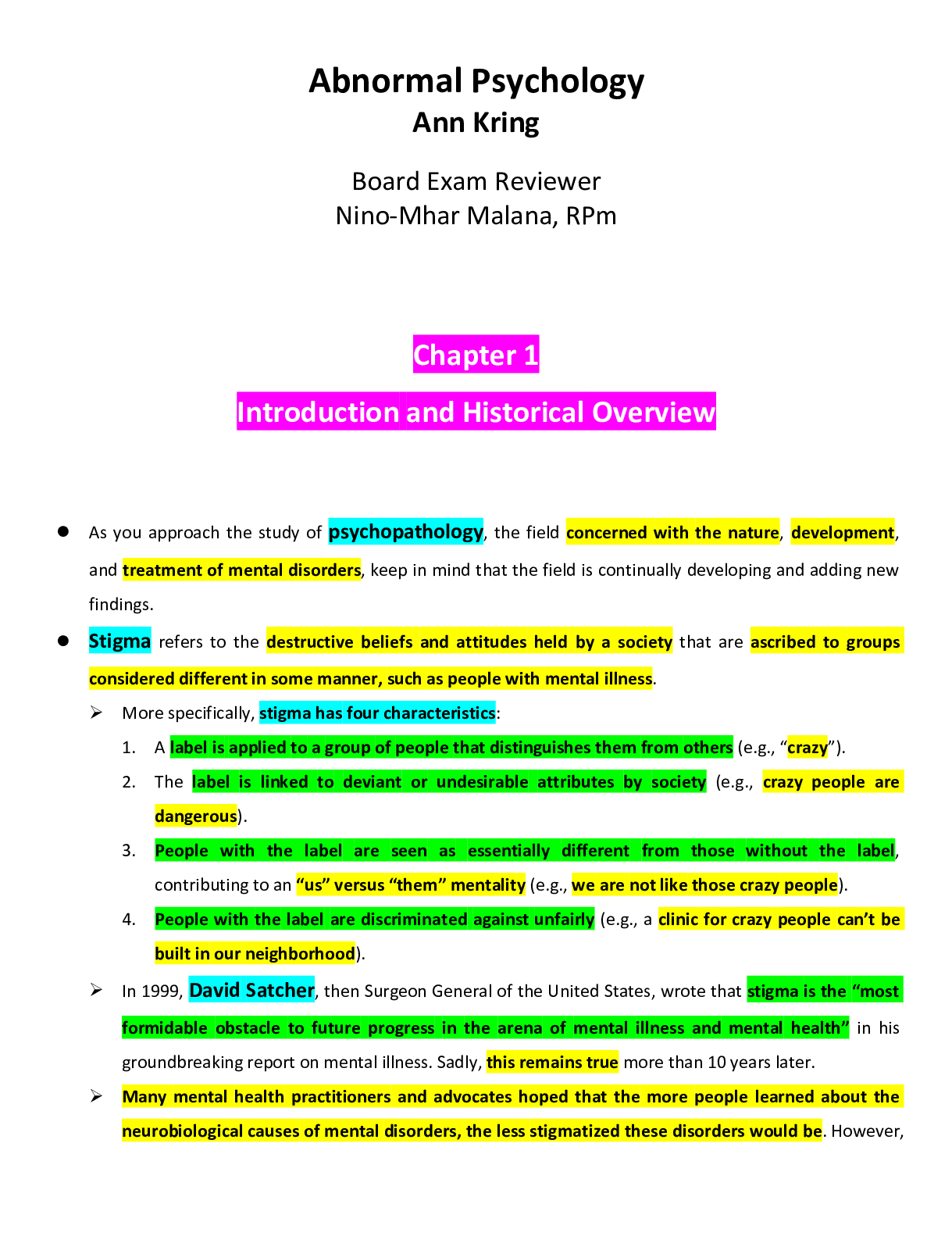
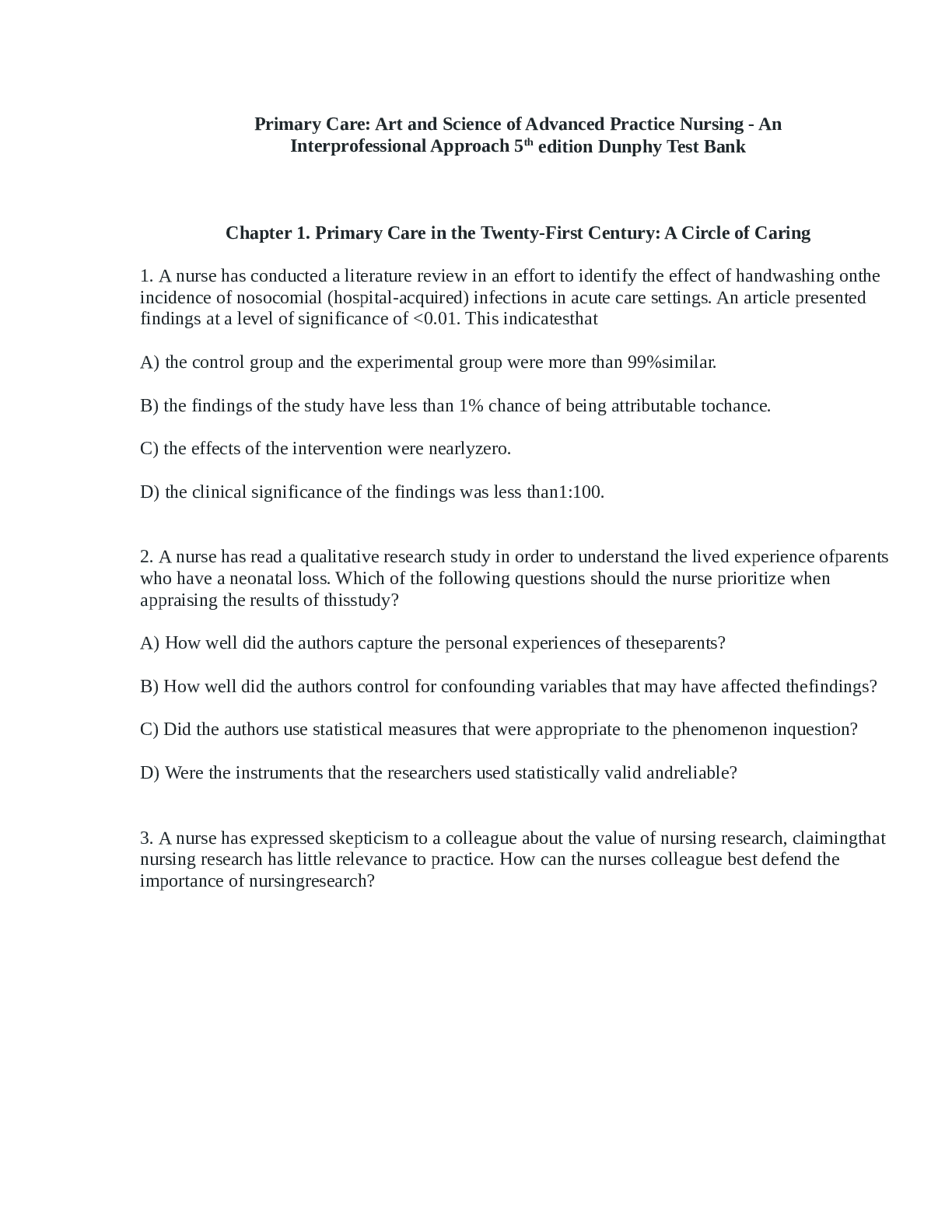
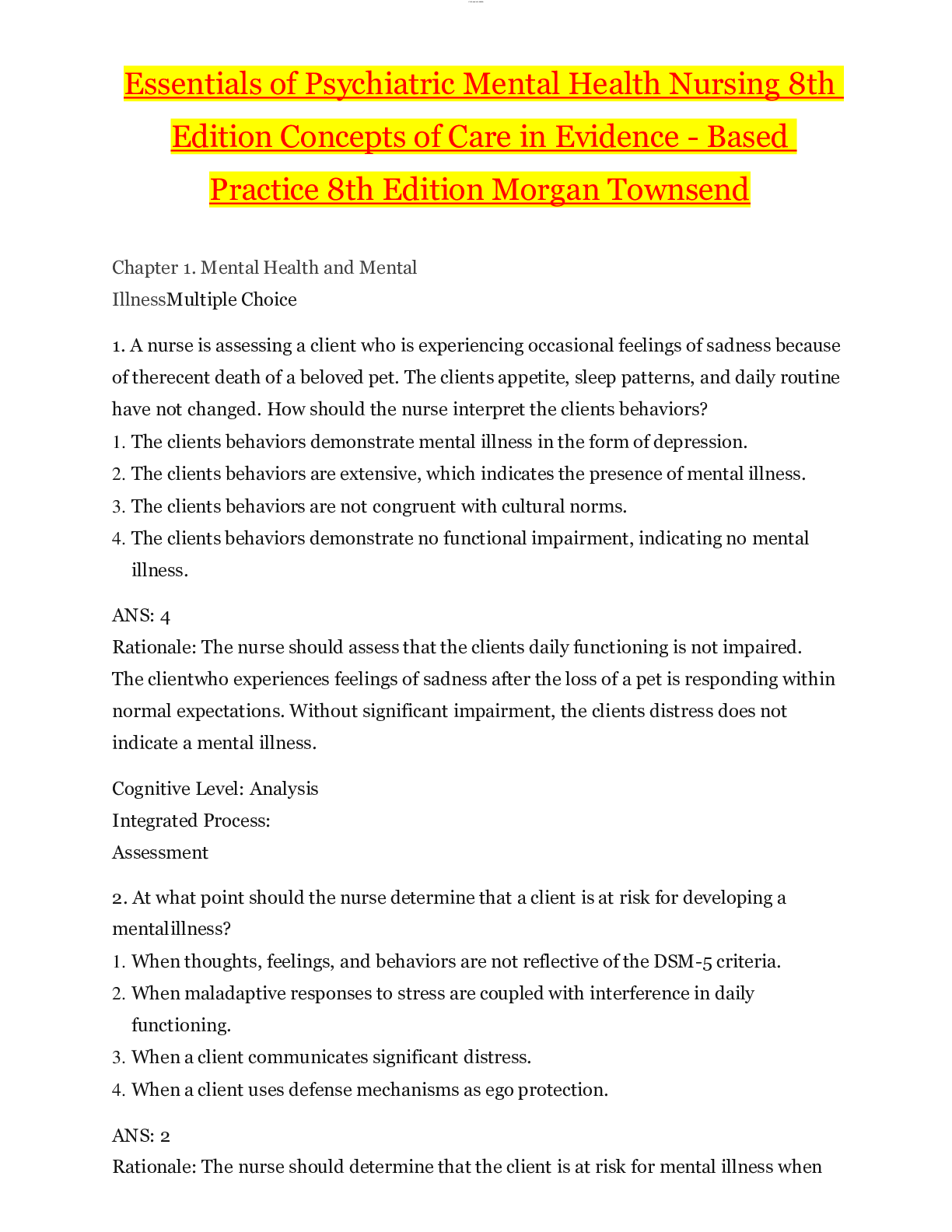


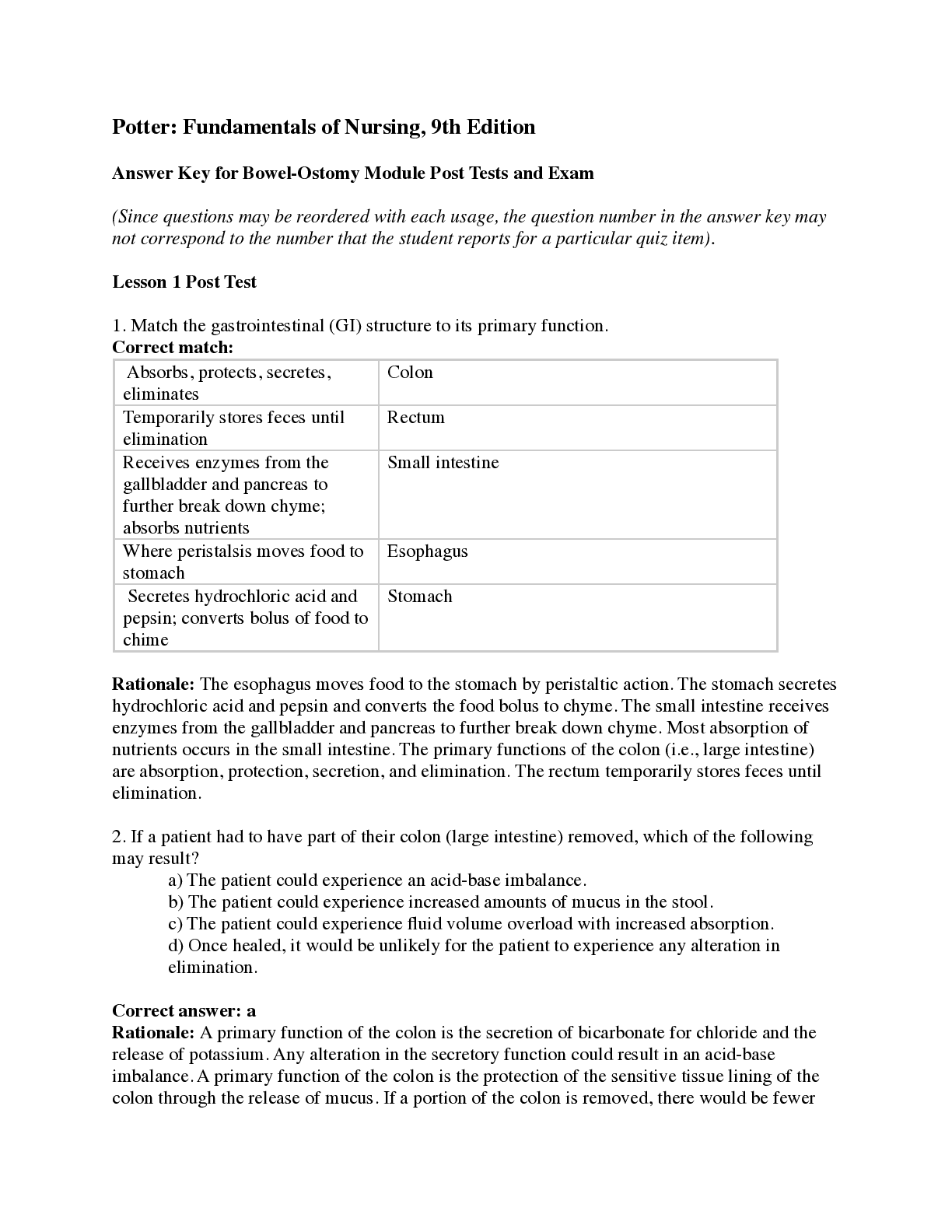
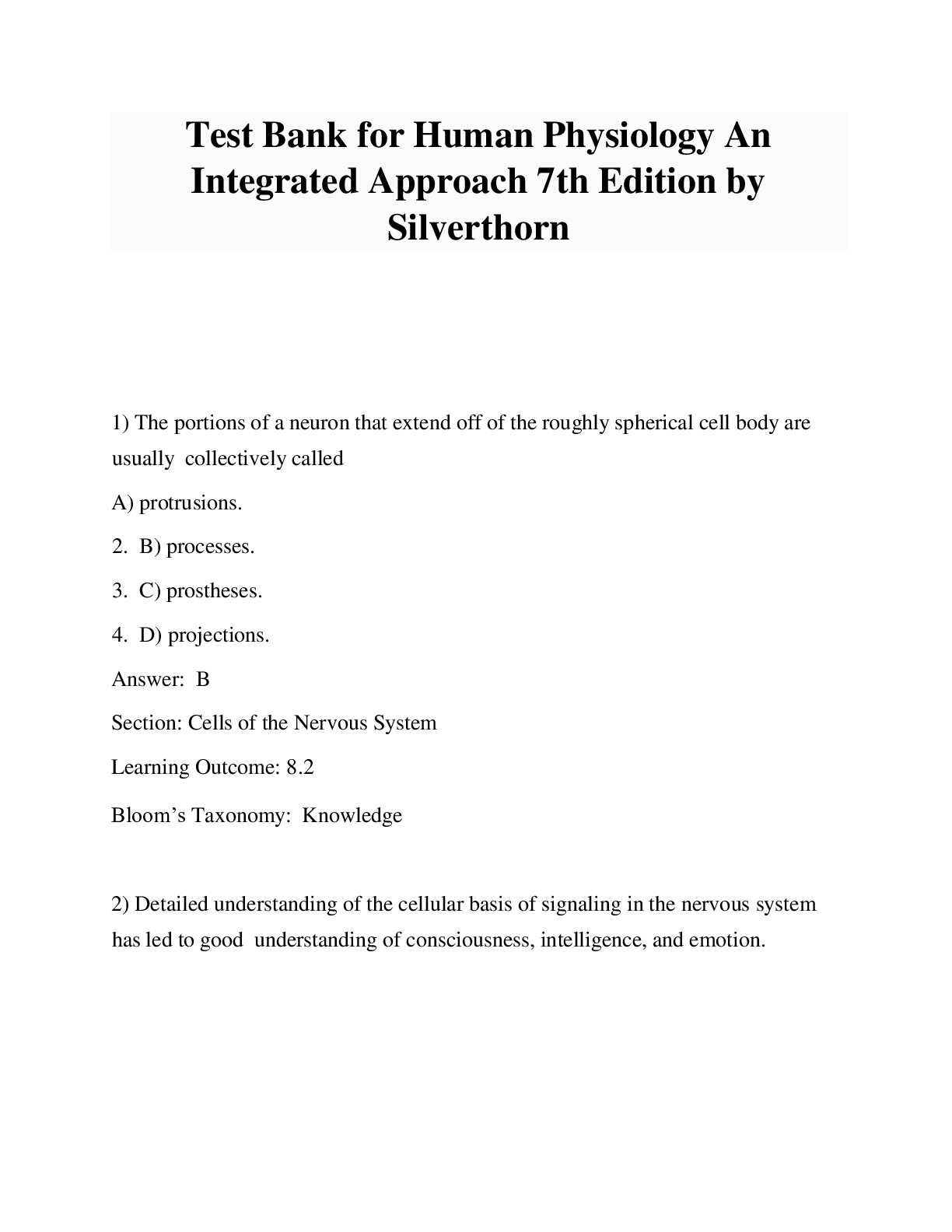
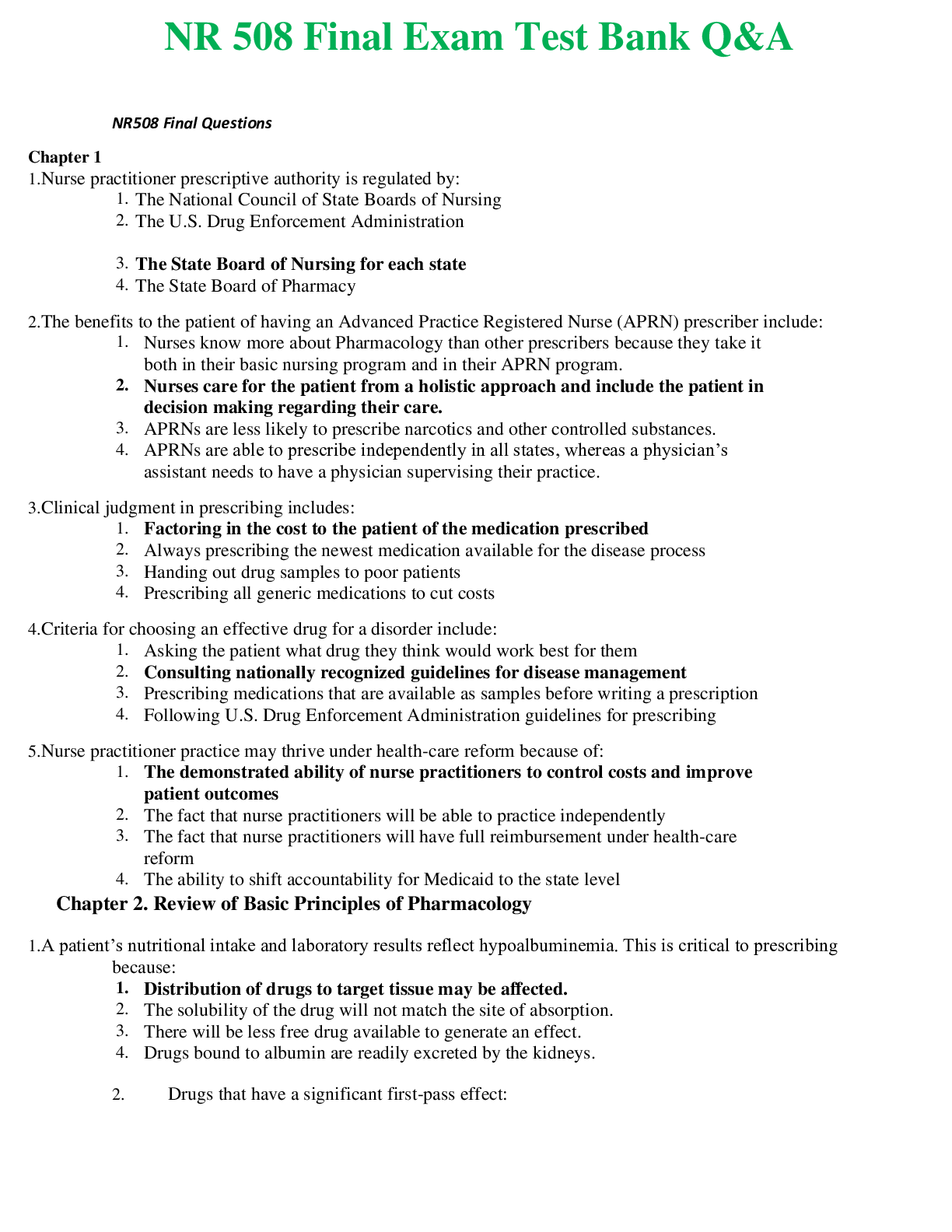
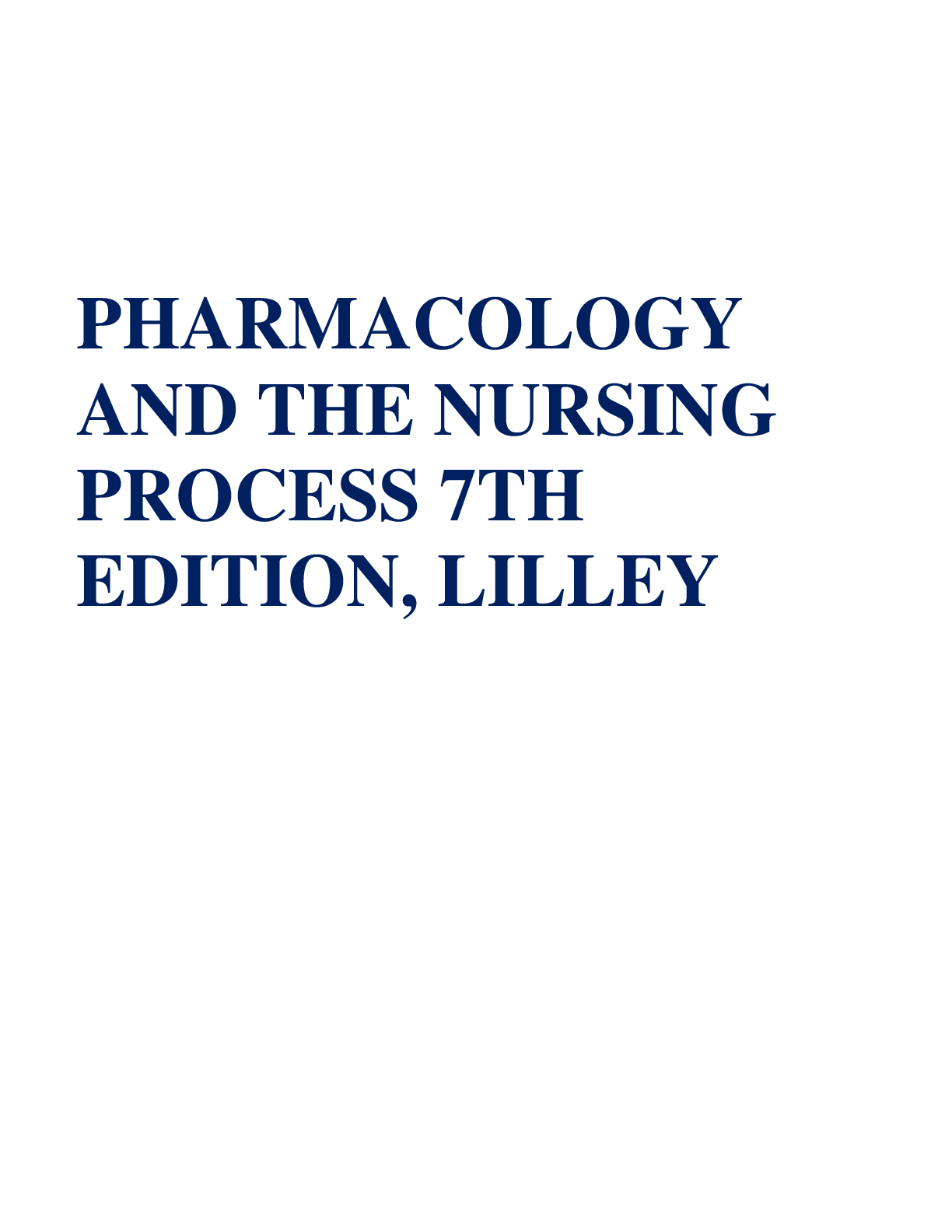
.png)
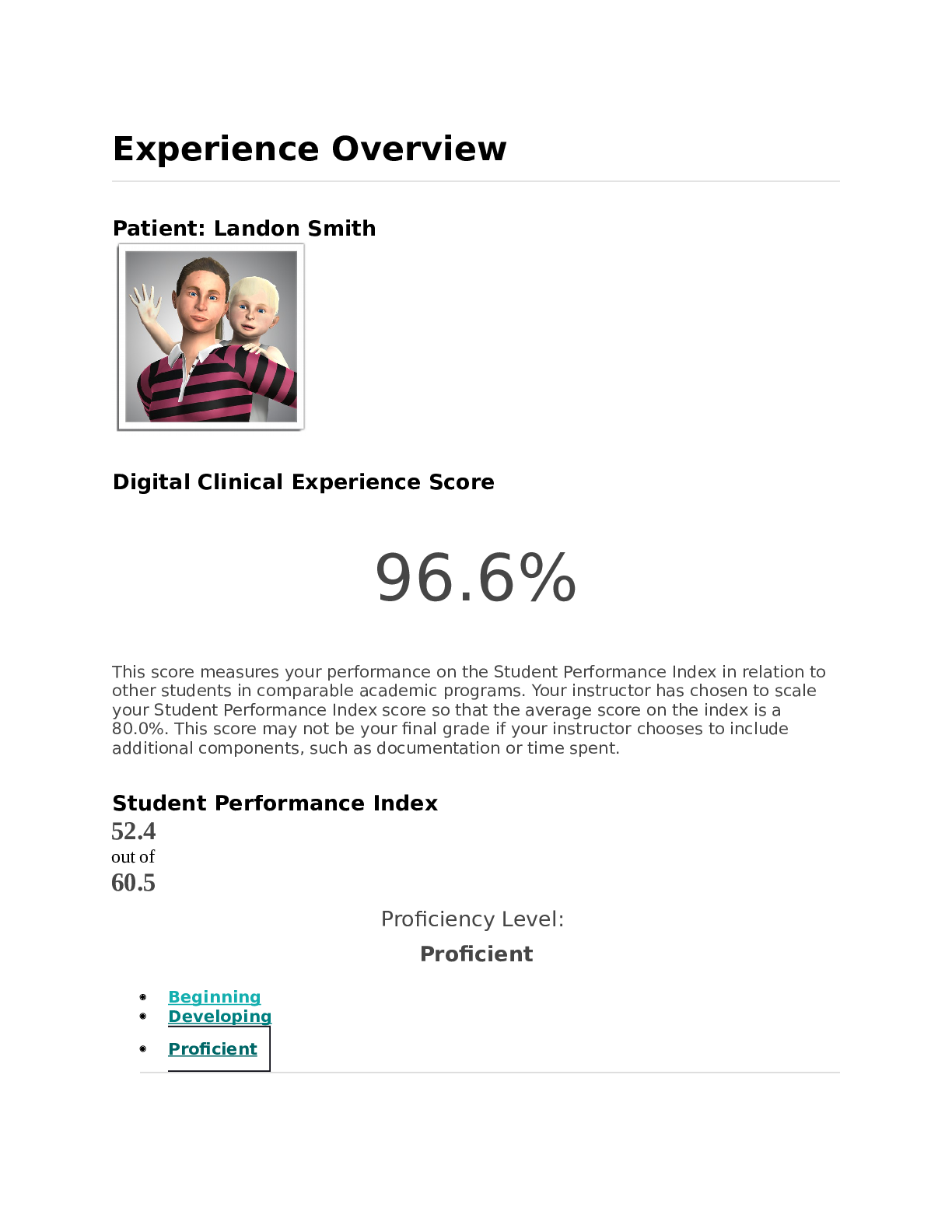

 questions & All correct answers - Chamberlain College of Nursing.png)


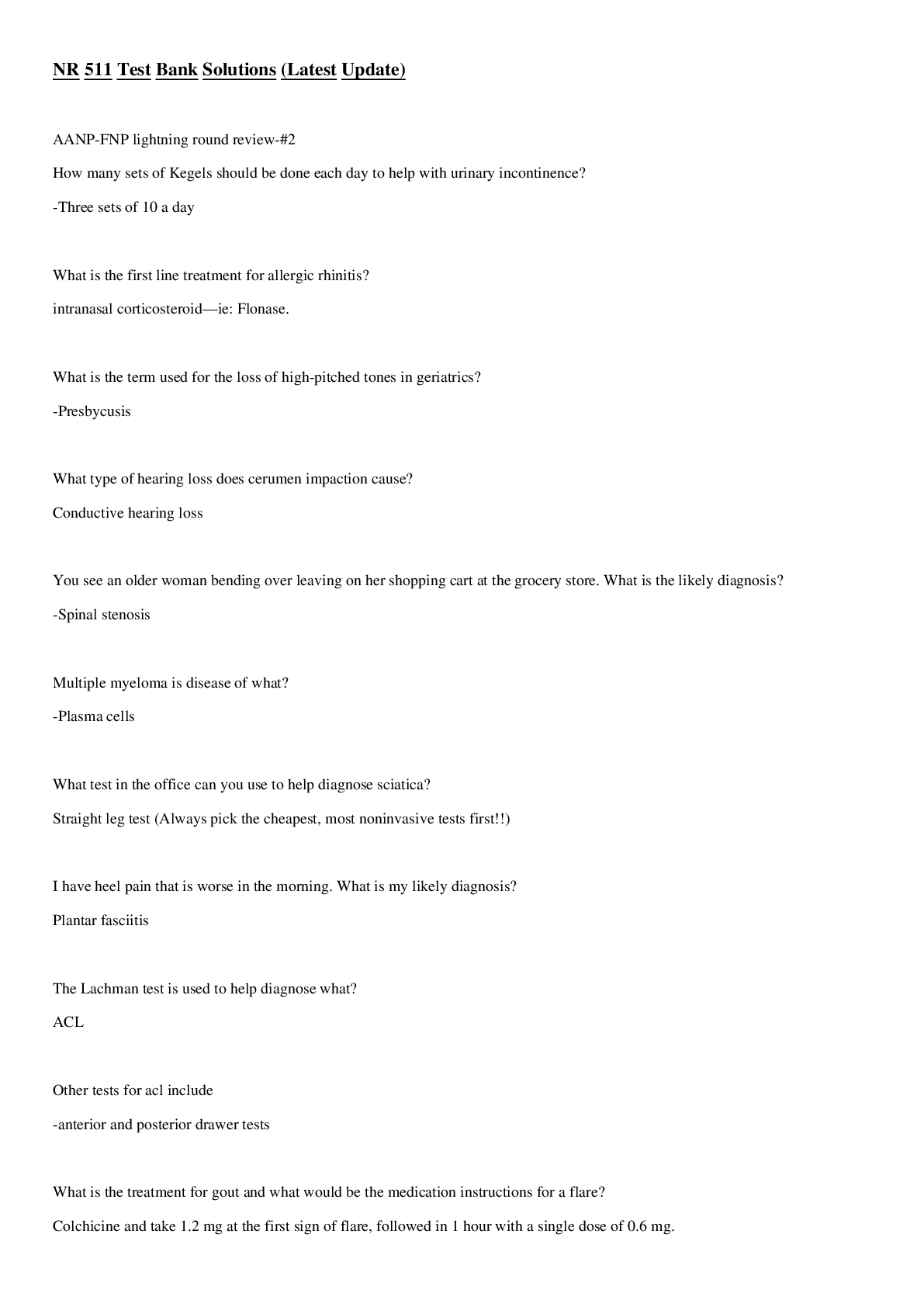



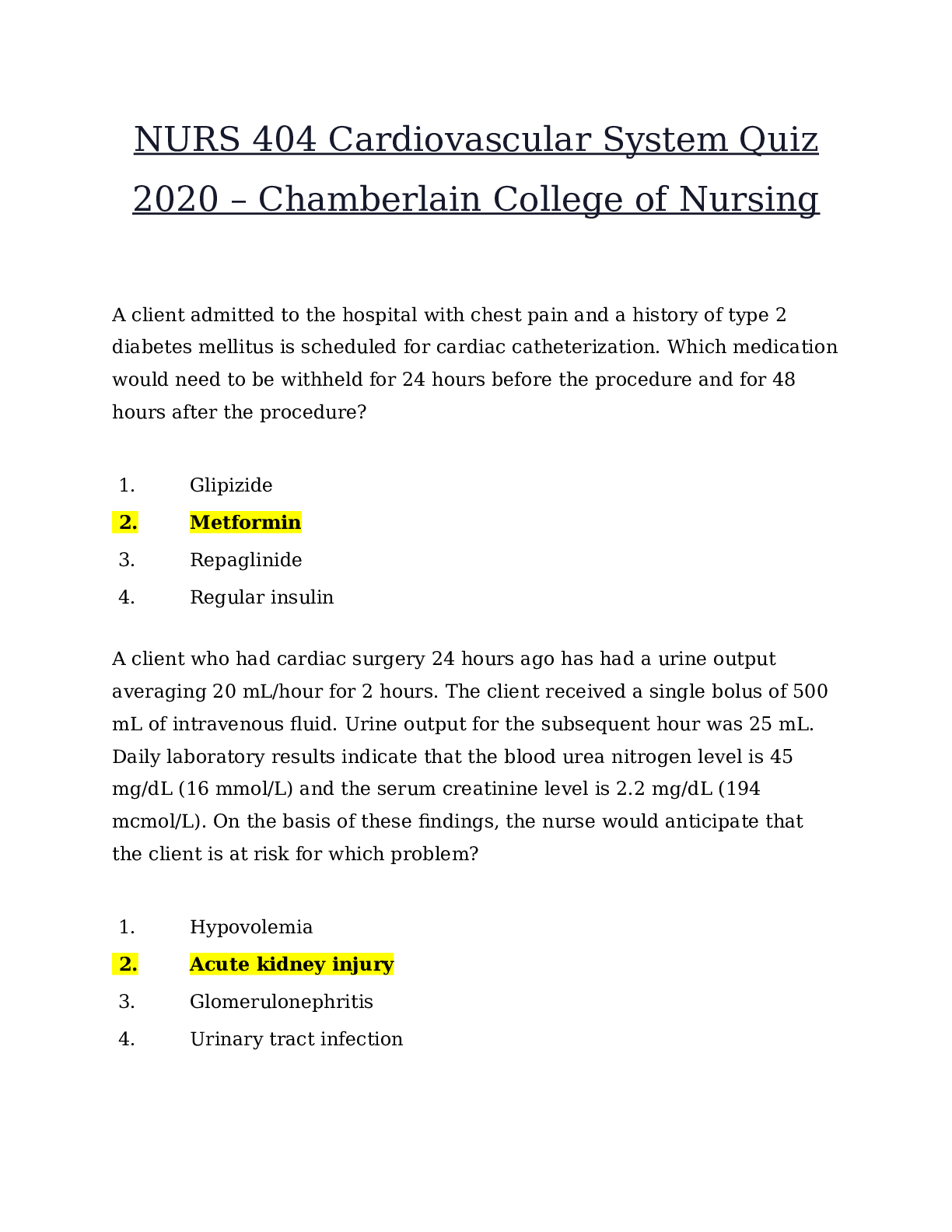
 EXAM TESTED QUESTIONS WITH ANSWERS AND EXPLANATIONS GRADED A.png)
.png)
